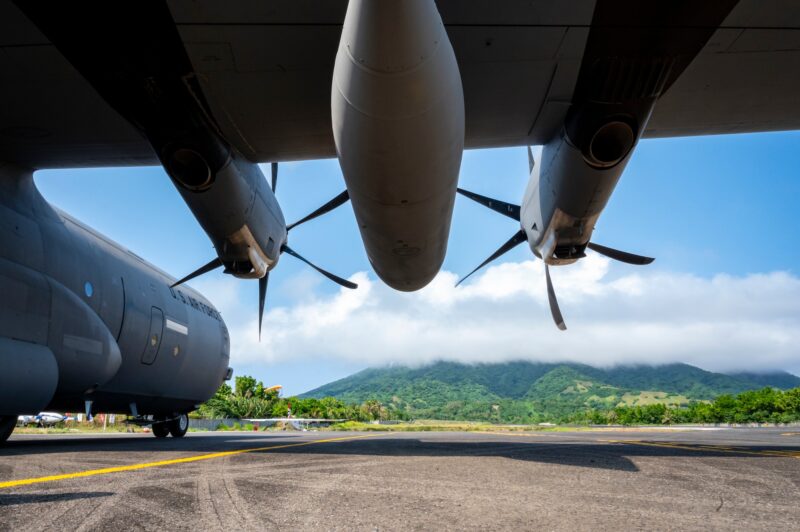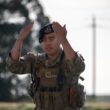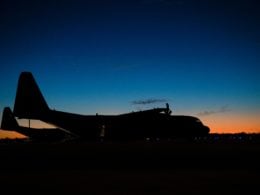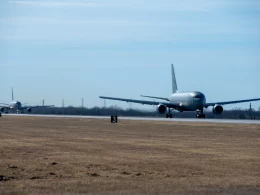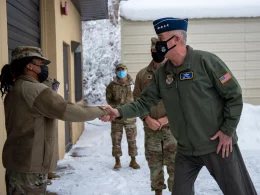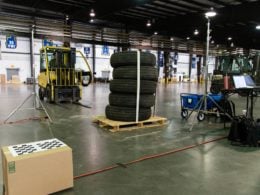ANDERSEN AIR FORCE BASE, Guam —
Following the completion of the first Maximum Endurance Operation with external fuel tanks, the 317th Airlift Wing continues to showcase tactical airlift capabilities for operating across vast distances and into remote islands during its two-week exercise, Hazard Spear.
“The Indo-Pacific theater offers strategic and operational challenges unlike any other,” said Col. Justin Diehl, 317 Operations Group commander. “Hazard Spear validates our ability to execute all of our current and new mission sets in and around the First and Second Island Chains.”
Hazard Spear was designed to rehearse rapid Joint Force Integration in the Commonwealth of the Northern Marianas Islands and the Philippines. In conjunction with the Marines in both Exercise LuHo IV and Exercise Balikatan 2024, Hazard Spear validates the 317th Operations Group’s top mission priorities.
“We identified a critical need from the Joint force to rapidly forward deploy fuel and logistics to locations that cannot support large strategic airlift or maritime delivery,” said Maj. Alex Leach, Mission Commander and 40th AS assistant director of operations. “The ability to quickly mobilize and operate to austere spoke locations from the Second Island chain further west is a gamechanger on how we think about tactical C-130J airlift.The ability to carry extra fuel with external tanks allows us to be completely self-reliant and move between the island chains seamlessly.”
During the exercise, three C-130Js were dispatched to different locations from Andersen Air Force Base, Guam to support Exercise Balikatan 24 in the Philippines, marking the wing’s first participation in the event in years. Balikatan is an annual military exercise between the United States and the Philippines, typically involving over 20,000 military personnel. The exercise is intended to strengthen interoperability and cooperation between the two countries through joint training, exercises, and humanitarian assistance.
From April 26 through 28, two Dyess C-130Js demonstrated the ability to rapidly deploy a Marine unit into a remote island location and immediately offloaded thousands of gallons of fuel. Not only did this assist the Joint Force in commencing operations, but eliminated the requirement for ships to bring fuel into a port. One C-130J departed from Guam flying directly to Lal-Lo Airfield in Northern Luzon, then moved the unit and fuel to Basco Airfield on Batan Island, Philippines, setting a record for the largest aircraft to ever land at the airfield.
The other aircraft staged out of Kadena Air Base, Japan, transporting fuel directly into the small island. At Basco, the Marines set up Specialized Fueling Operations at Forward Area Refueling Points (FARPs), which serve as key refueling sites located near the front lines or in forward operating areas. These strategic areas enable aircraft and vehicles to quickly refuel and continue their missions without the need to travel back to a main base.
Throughout Hazard Spear, the 317th AW highlighted the use of dispersal operations—spreading out personnel and resources to complete multiple mission objectives simultaneously. Notably, the Airlift Wing’s Maintenance Group utilized their Rapid Expeditionary Toolkit (REX-Kit), a mobile maintenance kit equipped with satellite connections to bring immediate connectivity to teams. Graduates from their Lethal Expeditionary Airman Development (LEAD) program took charge by testing data link systems, successfully reducing their manpower yet providing the same level of support.
“The whole idea, is that we can launch a fleet to conduct decentralized ops, testing our connectivity as a unit,” said Tech. Sgt. Isaac Smith, 317th Aircraft Maintenance Squadron crew chief. “Being able to have real-time updates enroute allows us to perform more efficiently in remote locations.”
Following the completion of Hazard Spear, the 317th AW will have demonstrated a wide range of tactical airlift solutions, allowing them to achieve Full Operational Capability across several new mission sets. From island-hopping to loading/offloading High Mobility Artillery Rocket Systems (HIMARS), the wing has significantly flexed its air mobility capacity.
“We have spent the last two years accelerating new mission sets to include defueling operations, rapidly deploying into an expansive theater with external fuel tanks, landing on blacked-out unmarked surfaces, employing Tactical Operation Center Command and Control capabilities, and perfecting quick maintenance repair capabilities,” said Diehl. Reflecting on the exercise’s significance, he elaborated, “All of these efforts are geared toward providing senior commanders even more solutions in vast theaters and solving complex problems spread across austere island locations.”
Through these types of exercises, the wing not only showcases the capabilities of Airmen, but contributes to the broader strategic objective of maintaining a competitive edge in the era of Great Power Competition. The 317th AW paves a path for future agile combat employment in the Indo-Pacific theater, amplifying joint force readiness and securing operational advantage while ensuring the Air Force remains at the forefront of global power projection.




